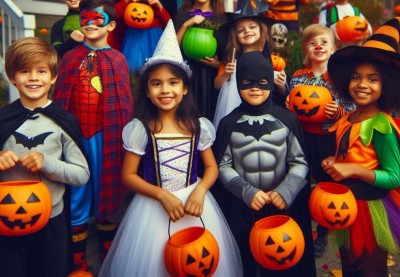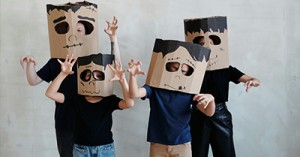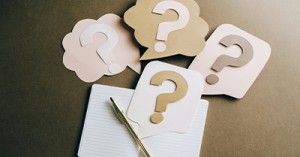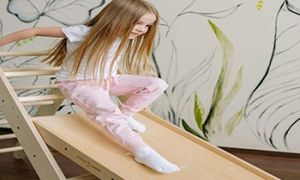Celebrating Halloween in early childhood settings in Australia can be a fun and enriching experience. The following article provides the Pros and Cons Of Celebrating Halloween, Learning Goals For Halloween A Theme, Halloween Activities For Toddlers and Preschoolers, Linking Halloween To The EYLF and more.
Pros of Celebrating Halloween:
-
Creativity and Imagination: Halloween activities like costume-making, pumpkin carving, and spooky crafts can stimulate children’s creativity and imagination.
-
Cultural Awareness: Even though Halloween is traditionally an American holiday, it has become more popular in Australia. Celebrating it can help children learn about different cultural traditions.
-
Community Building: Halloween can be a great opportunity for children to engage with their peers and the community through events like trick-or-treating or Halloween parties.
-
Fun and Engagement: Themed activities can make learning fun and engaging, helping children develop a positive attitude towards school and learning.
Cons of Celebrating Halloween:
-
Cultural Sensitivity: Some families may not celebrate Halloween due to personal, cultural, or religious beliefs. It’s important to be respectful and inclusive of all children and their backgrounds.
-
Safety Concerns: Halloween activities, especially those involving costumes and trick-or-treating, need to be carefully planned to ensure children’s safety.
-
Fear and Anxiety: Some Halloween themes can be scary for young children. It’s important to choose age-appropriate activities that won’t cause fear or anxiety.
Tips for Celebrating Halloween in Early Childhood Settings:
-
Inclusive Activities: Plan activities that all children can participate in, regardless of their background. For example, focus on fun crafts and games rather than scary themes.
-
Parental Involvement: Communicate with parents about the planned activities and get their input. This helps ensure that the celebration is respectful of all families’ preferences.
-
Safety First: Ensure that all activities are safe and supervised. Avoid costumes or decorations that could be hazardous.
Ultimately, whether or not to celebrate Halloween in your early childhood setting is a decision that should be made based on the needs and preferences of your community. It can be a wonderful opportunity for fun and learning if approached thoughtfully and inclusively.
Learning Goals For A Halloween Theme
Integrating Halloween into your early childhood curriculum can be a great opportunity to achieve various learning goals. Here are some age-appropriate learning goals you can focus on:
1. Social-Emotional Learning (SEL):
-
Empathy and Understanding: Discussing different costumes and characters can help children understand and appreciate diversity.
-
Cooperation and Sharing: Group activities like pumpkin decorating or costume parades encourage teamwork and sharing.
-
Managing Emotions: Activities that involve pretend play can help children express and manage their emotions in a safe environment.
2. Language and Literacy:
-
Vocabulary Building: Introduce new words related to Halloween, such as “pumpkin,” “costume,” “spooky,” etc.
-
Storytelling: Encourage children to create and share their own Halloween stories, enhancing their narrative skills.
-
Reading Comprehension: Read Halloween-themed books and discuss the stories to improve comprehension skills.
3. Cognitive Development:
-
Problem-Solving: Activities like Halloween puzzles or scavenger hunts can enhance problem-solving skills.
-
Counting and Sorting: Use Halloween-themed items (like candy or small toys) for counting and sorting exercises.
-
Pattern Recognition: Create patterns with Halloween objects (e.g., alternating colors of candy) to develop pattern recognition skills.
4. Fine and Gross Motor Skills:
-
Fine Motor Skills: Crafts like cutting out shapes, painting, or threading beads can improve fine motor skills.
-
Gross Motor Skills: Games like “Monster Freeze Dance” or obstacle courses can help develop gross motor skills.
5. Creativity and Imagination:
-
Art Projects: Encourage children to create their own Halloween decorations or costumes.
-
Role Play: Set up a pretend play area with Halloween props to stimulate imaginative play.
6. Cultural Awareness:
-
Learning About Traditions: Discuss the origins and customs of Halloween and compare them with other cultural celebrations.
-
Inclusive Celebrations: Ensure activities are inclusive and respectful of all cultural backgrounds.
7. Safety Awareness:
-
Safety Rules: Teach children about safety rules for trick-or-treating, such as staying with an adult and checking candy before eating it.
By focusing on these learning goals, you can create a Halloween celebration that is both fun and educational for young children.
Halloween Activities For Toddlers and Preschoolers
Here are some fun and age-appropriate Halloween activities for young children:
Crafts and Art Projects:
-
Pumpkin Painting: Instead of carving, children can paint pumpkins with non-toxic paints.
-
Paper Plate Masks: Kids can create masks using paper plates, markers, and other craft supplies.
-
Handprint Spiders: Use black paint to make handprint spiders on paper, adding googly eyes for fun.
Sensory Activities:
-
Spooky Sensory Bins: Fill bins with items like dried pasta, rice, or beans, and add small Halloween-themed toys.
-
Slime Making: Create safe, non-toxic slime with ingredients like cornstarch and water, adding food coloring for a spooky effect.
Games and Physical Activities:
-
Pumpkin Bowling: Use small pumpkins as bowling balls and set up pins made from empty bottles.
-
Monster Freeze Dance: Play Halloween-themed music and have children dance like monsters, freezing when the music stops.
-
Ghost Hunt: Hide paper ghosts around the classroom or playground for children to find.
Storytime and Songs:
-
Halloween Stories: Read age-appropriate Halloween books like “Room on the Broom” by Julia Donaldson.
-
Halloween Songs: Sing fun songs like “Five Little Pumpkins” or “The Skeleton Dance.”
Cooking and Snacks:
-
Decorate Cookies: Provide plain cookies and let children decorate them with icing and sprinkles.
-
Fruit Monsters: Use fruits like bananas and grapes to create fun monster faces.
Dress-Up and Role Play:
-
Costume Parade: Have a simple costume parade where children can show off their costumes.
-
Role Play: Set up a pretend play area with Halloween-themed props and costumes.
These activities can help children enjoy the festive spirit of Halloween in a safe and inclusive way.
Alternatives To Halloween
If you’re looking for alternatives to celebrating Halloween in early childhood settings, here are some fun and inclusive ideas:
1. Fall Festival:
Host a fall-themed festival with activities like apple bobbing, sack races, and pumpkin decorating. This can be a great way to celebrate the season without focusing on Halloween.
2. Harvest Party:
Celebrate the harvest season with activities such as making scarecrows, leaf crafts, and tasting seasonal foods like apples and pumpkins.
3. Costume Day:
Have a costume day where children can dress up as their favorite characters, animals, or professions. This can be done without the spooky Halloween theme.
4. Nature Walk:
Organize a nature walk to explore the changes in the environment during fall. Collect leaves, acorns, and other natural items to use in classroom activities.
5. Storybook Parade:
Encourage children to dress up as their favorite storybook characters and have a parade. This promotes literacy and allows for creative expression.
6. Cultural Celebration:
Celebrate a variety of cultural festivals that occur around the same time, such as Diwali or Día de los Muertos. This can be an opportunity to teach children about different traditions and customs.
7. Pajama Day:
Have a cozy pajama day where children can come to school in their pajamas and enjoy a day of storytelling, movies, and relaxation.
8. Science Day:
Plan a day of fun science experiments and activities. This can include making slime, exploring the properties of pumpkins, or simple chemistry experiments.
9. Art and Craft Fair:
Set up an art and craft fair where children can create and display their artwork. This can include fall-themed crafts and other creative projects.
10. Community Service:
Engage children in a community service project, such as making cards for a local nursing home or collecting food for a food bank. This teaches empathy and the importance of helping others.
These alternatives can provide a festive and enjoyable experience for children while respecting diverse backgrounds and preferences.
Linking Halloween To The EYLF Outcomes
Linking Halloween activities to the Early Years Learning Framework (EYLF) outcomes can help ensure that your celebrations are both fun and educational. Here are some ways to connect Halloween-themed activities to the EYLF outcomes:
Outcome 1: Children Have a Strong Sense of Identity
-
Costume Dress-Up: Encourage children to dress up in costumes, which allows them to explore different roles and identities. This can help them develop a sense of self and confidence.
-
Storytelling: Have children create and share their own Halloween stories, fostering a sense of belonging and self-expression.
Outcome 2: Children Are Connected with and Contribute to Their World
-
Cultural Exploration: Discuss the origins of Halloween and compare it with other cultural celebrations. This helps children understand and respect different traditions and communities.
-
Community Involvement: Organize a Halloween parade or event that involves families and the local community, promoting a sense of connection and contribution.
Outcome 3: Children Have a Strong Sense of Wellbeing
-
Physical Activities: Plan outdoor games like pumpkin bowling or a ghost hunt to promote physical health and wellbeing.
-
Emotional Expression: Use Halloween-themed role play to help children express and manage their emotions in a safe and supportive environment.
Outcome 4: Children Are Confident and Involved Learners
-
Problem-Solving Activities: Engage children in Halloween-themed puzzles or scavenger hunts to develop their problem-solving and critical thinking skills.
-
Creative Projects: Encourage children to participate in Halloween crafts, such as making masks or decorating pumpkins, to foster creativity and active learning.
Outcome 5: Children Are Effective Communicators
-
Language Development: Introduce new Halloween-related vocabulary and encourage children to use these words in conversations and storytelling.
-
Group Discussions: Facilitate group discussions about Halloween traditions and activities, helping children develop their communication and social skills.
By aligning Halloween activities with the EYLF outcomes, you can create a meaningful and enriching experience for children that supports their overall development.
Further Reading
References:
Halloween Forest School Activities, Rhubarb and Wren
Halloween Nature Activities, Woodland Trust
Halloween Activities For The Classroom, We Are teachers
Halloween Lesson Plans, Book Widgets







 As an Educator in Australia, your pay rate falls under the Children’s Services Award 2010. This award states the minimum amount that an employer can
As an Educator in Australia, your pay rate falls under the Children’s Services Award 2010. This award states the minimum amount that an employer can When working as a qualified Early Childhood Teacher (with a university degree) within a service, your rate of pay will come from the Educational Services
When working as a qualified Early Childhood Teacher (with a university degree) within a service, your rate of pay will come from the Educational Services When working as a Diploma Qualified Educator your pay rate is from the Children's Services Award 2010. This Award states your minimum rate of pay
When working as a Diploma Qualified Educator your pay rate is from the Children's Services Award 2010. This Award states your minimum rate of pay When working as a Cert 3 Qualified Educator, your pay rate is from the Children's Services Award 2010. This Award states your minimum rate of
When working as a Cert 3 Qualified Educator, your pay rate is from the Children's Services Award 2010. This Award states your minimum rate of Educational Leaders play a crucial role in their early childhood service by ensuring that the educational program aligns with best practices and supports the holistic
Educational Leaders play a crucial role in their early childhood service by ensuring that the educational program aligns with best practices and supports the holistic In early childhood education and care, ratios are more than a technicality—they are a frontline safeguard. Every child deserves responsive supervision, emotional connection, and developmental
In early childhood education and care, ratios are more than a technicality—they are a frontline safeguard. Every child deserves responsive supervision, emotional connection, and developmental With the new national child safety reforms kicking in on 1 September 2025, early childhood services like yours have a real opportunity to lead the
With the new national child safety reforms kicking in on 1 September 2025, early childhood services like yours have a real opportunity to lead the Here’s a comprehensive Mobile Phone and Smart Watch Policy tailored for early childhood education and care (ECEC) services in Australia, aligned with the latest 2025
Here’s a comprehensive Mobile Phone and Smart Watch Policy tailored for early childhood education and care (ECEC) services in Australia, aligned with the latest 2025 The Sea of Fish Challenge is a national initiative that invites children, educators, families, and communities to create and display fish artworks as a symbol
The Sea of Fish Challenge is a national initiative that invites children, educators, families, and communities to create and display fish artworks as a symbol Across the early childhood education and care sector, educators are sounding the alarm: current staffing ratios are insufficient to deliver safe, meaningful, and developmentally appropriate
Across the early childhood education and care sector, educators are sounding the alarm: current staffing ratios are insufficient to deliver safe, meaningful, and developmentally appropriate


